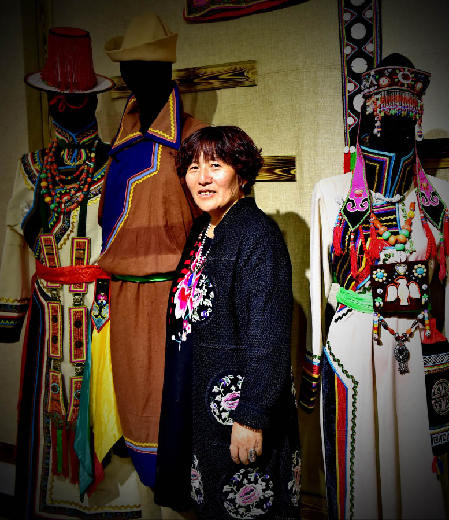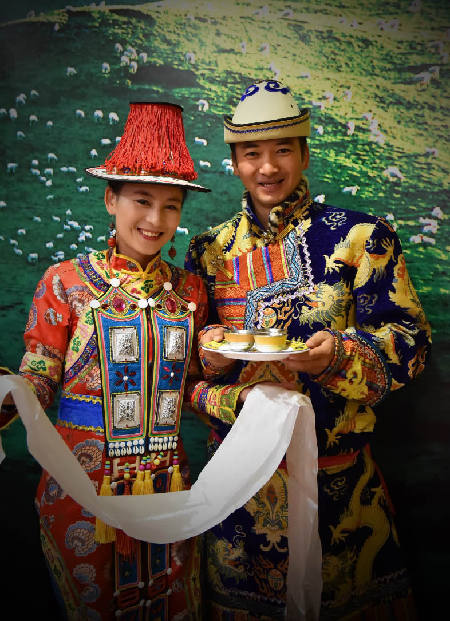Guardian of Ethnic Culture
By staff reporter JIAO FENG
 |
| Ka Cuiling and her collection. |
SUNAN in Zhangye City, Gansu Province, is the sole Yugur autonomous county in China. The Yugur ethnic group has a long history but a small size – 13,000 people in total. In addition to Mandarin, they speak several dialects, but have no written language.
Early Yugurs were nomads. With the change in their lifestyles thanks to modern influences, many traditions, crafts, and even the languages of the group are on the verge of extinction. This has spurred Ka Cuiling, a Yugur woman, to take on the mission of preserving and advancing her group’s cultural legacy.
My interview with Ka took place at night when she had just returned from downtown Zhangye. She showed me around the ethnic culture teaching and learning center, still under construction. The floor was strewn with Yugur costumes, trappings, and home appliances – her collection built up over the past decades. She founded the center with the goal of displaying these icons of Yugur culture so that more people could gain a better understanding of the group.
Sharing a Mother’s Passion
Ka, 53, has a close bond with her mother, who raised her and her siblings on her own after their father passed away at young age. To bring in extra cash, the mother tended the family herds during the day and took on sewing and handcrafting orders in the evening. “My mom is highly intelligent and can speak six languages. She loves our culture, and was a huge inspiration for me to start my collection of Yugur items,” Ka said.
She remembered that whenever her mother encountered a rarely used object she would explain to the children its function and lament its fading from their daily life, warning that it would soon disappear completely.
On graduation from junior high school, Ka began to help tend the family’s herds, grazing them with her mother every day. During these years she learned embroidery from her mother. She was so addicted to the craft that she would take home the clothes bearing embroidery patterns thrown out by other villagers. Later, she would sift through the waste for other items of cultural significance. People called her a “bin lady,” but her interest never waned.
Sacrificing Painting for Collection
Ka Cuiling taught herself how to paint in her early years and won a prize in a local competition in 1984, with which she landed a job at a local cultural institution, becoming the first female Yugur painter in the area. But she aimed higher – college. “It was extremely hard for me, with only a junior middle school education, to apply for higher education,” she explained. The tenacious young lady participated in eight sessions of the college entrance examination before she was recruited to the fine arts department of Northwest University for Nationalities in 1987, aged 25.
College life revealed a broader world to Ka Cuiling, enabling her to develop a deeper, more rational understanding of preservation of ethnic culture. She realized immediate action was needed. “When I entered college, I was older than the average students, already married and with children. But at that stage I had a better understanding of my group’s culture. I joined in many school activities, learned several ethnic crafts and became more involved in collection,” Ka said. “It was a critical period in my life, when not only my knowledge but also a sense of urgency grew. I was exposed to the worrying fact that as time passed and the social environment shifted, the nomadic culture of the Yugurs was slipping toward extinction.”
On graduating, Ka resumed her job with the county’s cultural institution with her mentor’s encouragement. In 1999 the preparatory committee of the China Millennium Monument invited designs for a totem of all ethnic groups. Ka’s work, featuring a divine deer wearing a pearl crown and carrying a snow lotus in its mouth, was chosen as the one representing her group and engraved on the relief.
But when her collection project expanded, requiring more money and input, Ka gave up her painting career. It was a hard decision, but she never regretted it. Her painting expertise turned out to be a great advantage in her hunt for worthy items.
 |
| Two models in gorgeous traditional Yugur costumes. |
Connoisseur on the Prairie
Ka Cuiling has visited every corner of the prairie inhabited by the Yugur people in the course of amassing her collection, following clues of antiques owned by local families. She would sell her property to buy any items of particular interest. If the owner refused to sell, she would make a sketch of the item, and meticulously study the techniques involved in its making.
One day she saw a bear-hide bag at a herder’s home, which was priced at RMB 2,000. But all she had was RMB 1,250. She managed to raise funds to match the asking price, but when she returned to the herder, the bag had been sold. Based on her drawing, she made a copy out of cowhide. “Such old items are gradually disappearing, and may never be seen again once they are gone. I draw and reproduce them so that later generations will have the chance to know what they are like,” she explained.
One day Ka visited the home of a leather carver, only to find out that he had passed away. She didn’t turn around and leave, instead she implored his family to teach her the craft. Moved by her sincerity, the man’s family patiently illustrated the entire process of leather sculpturing and sent her a full set of tools as a gift. Based on the notes and sketches she took during the stay, Ka mastered the skill of leather carving. Ka has finished a dozen sketch books in the process of her “treasure hunt.” The content, she says, constitutes an illustrated history of Yugur culture.
Ka has hoarded thousands of artifacts over the past 30 years. Some people have suggested she sell them for a profit, but she categorically refuses: “I won’t sell a single item, and that’s what I told my children. The whole Yugur population is a little more than 10,000. If we all leave behind one item, that’s only 10,000 items. If I sell my collection, what can we pass on to our descendants?”
The grip of modern life and amenities is felt particularly strongly among traditionally nomadic people. As Ka observed, most of her fellow Yugurs no longer know how to pitch tents or drive horse/cattle-pulled carriages, among other practices that were formerly part of daily life. This change dilutes the groups’ memory of the past and their ancestors. She agreed that it is inevitable that some things will be lost with the passage of time, but efforts must be made to preserve as much as possible. An ethnic group must keep their culture alive.
Ka Cuiling has become a household name among Yugurs. She is approached by her peers with clues regarding antiques or gifts of cultural significance. She showed me a string of prayer beads from a lady who died at the age of 115. Her grandson sent it to Ka a few days prior to our interview. “He gave it to me for free because he knew that I collect these items not for profit but with the intention of saving them for the future.”
Founding a Cultural Reserve
After being nominated inheritor of Yugur leather carving by the provincial government and successor of Yugur clothing by the state, Ka Cuiling felt an obligation to do even more for her people. In 2014 she raised funds to build a typical Yugur village on a 20,000-sq-km plot of land appropriated by the local government. There, residents live according to old traditions and speak only their mother tongue. Some old games and modes of production have also been restored and revived, such as sheep-shearing contests.
When Ka Cuiling’s daughter married, her wedding was staged in the village following traditional rites. It was a custom of the Yugurs for the mother to make a woolen outer garment that she presented to her daughter wrapped in a tiny bundle at the wedding. The dress had to be made of a light, thin, handwoven fabric. But as nobody can spin the fine yarn needed for such a gauzy textile nowadays, this part of the traditional Yugur wedding ritual was missing. This instance is one of the many that agonizes Ka. “The purpose of launching this project is for me to pass down what is in danger of dying out.”
The village is now open to the public as a tourist resort. The ethnic culture teaching and learning center is near completion, and will enter formal operation next year. Ka Cuiling is also planning a symposium on Yugur clothing and trappings, during which the past and contemporary fashion trends of her group will be displayed. This enterprising matron is offering training to 200-plus young people, whom she hopes will carry on her mission of protecting and promoting the Yugur ethnic culture.
